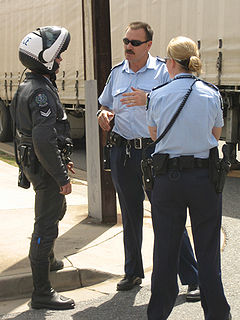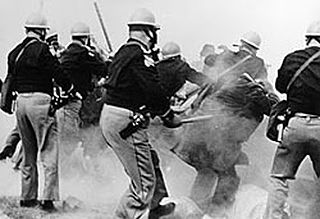
Closed-circuit television (CCTV), also known as video surveillance, is the use of video cameras to transmit a signal to a specific place, on a limited set of monitors. It differs from broadcast television in that the signal is not openly transmitted, though it may employ point-to-point (P2P), point-to-multipoint (P2MP), or mesh wired or wireless links. Though almost all video cameras fit this definition, the term is most often applied to those used for surveillance in areas that may need monitoring such as banks, stores, and other areas where security is needed. Though videotelephony is seldom called "CCTV" one exception is the use of video in distance education, where it is an important tool.

A police officer, also known as an officer, policeman, or a policewoman is a warranted law employee of a police force. In most countries, "police officer" is a generic term not specifying a particular rank. In some, the use of the rank "officer" is legally reserved for military personnel.

Sousveillance is the recording of an activity by a participant in the activity, typically by way of small wearable or portable personal technologies. The term "sousveillance", coined by Steve Mann, stems from the contrasting French words sur, meaning "above", and sous, meaning "below", i.e. "surveillance" denotes the "eye-in-the-sky" watching from above, whereas "sousveillance" denotes bringing the camera or other means of observation down to human level, either physically, or hierarchically.

The Belfast International Airport Constabulary (BIAC) is a small, specialised police force responsible for providing policing to the Belfast International Airport in Aldergrove, Northern Ireland. Officers employed by the force as empowered to act as Constables in accordance with the Airport Order 1994 whilst on land owned or controlled by the airport. The Belfast International Airport Constabulary is the last remaining privately funded airport police force in the United Kingdom, however airport forces still operate in the Republic of Ireland and the Isle of Man.
Police misconduct refers to inappropriate conduct and/or illegal actions taken by police officers in connection with their official duties. Types of misconduct include: coerced false confession, intimidation, false arrest, false imprisonment, falsification of evidence, spoliation of evidence, police perjury, witness tampering, police brutality, police corruption, racial profiling, unwarranted surveillance, unwarranted searches, and unwarranted seizure of property. Other types of misconduct include:
Axon Enterprise, Inc. is a Scottsdale, Arizona-based company which develops technology and weapons products for law enforcement and civilians.
Law enforcement in the United States is one of three major components of the criminal justice system of the United States, along with courts and corrections. Although each component operates semi-independently, the three collectively form a chain leading from an investigation of suspected criminal activity to the administration of criminal punishment.
Police accountability involves holding both individual police officers, as well as law enforcement agencies responsible for effectively delivering basic services of crime control and maintaining order, while treating individuals fairly and within the bounds of law. Police are expected to uphold laws, regarding due process, search and seizure, arrests, discrimination, as well as other laws relating to equal employment, sexual harassment, etc. Holding police accountable is important for maintaining the public's "faith in the system". Research has shown that the public prefers independent review of complaints against law enforcement, rather than relying on police departments to conduct internal investigations. There is suggestion that such oversight would improve the public's view on the way in which police officers are held accountable.

Police brutality is the use of excessive and/or unnecessary force by personnel affiliated with law enforcement duties when dealing with suspects and civilians. The term is also applied to abuses by corrections personnel in municipal, state, and federal penal facilities, including military prisons.

Ring Inc. is a home security and smart home company owned by Amazon. Ring manufactures home security products that incorporate outdoor motion-detecting cameras, including Ring Video Doorbell. It hosts an app, Neighbors, for online social sharing of captured footage among users. Ring also provides video footage from its cameras and data from its Neighbors app to law enforcement agencies on request. Its police partnerships have been criticized by civil rights advocacy groups as building an invasive private surveillance network.

A dashcam, dashboard camera, car DVR, driving recorder, or event data recorder (EDR) is an onboard camera that continuously records the view through a vehicle's front windscreen and sometimes rear or other windows. Some dashcams include a camera to record the interior of the car in 360 degrees inside camera, usually in a ball form and can automatically send pictures and video using 4G.

Body worn video (BWV), also known as body cameras and body-worn cameras, or wearable cameras is a wearable audio, video, or photographic recording system.
On July 19, 2015, in Cincinnati, Ohio, Samuel DuBose, an unarmed man, was fatally shot by Ray Tensing, a University of Cincinnati police officer, during a traffic stop for a missing front license plate and a suspended driver's license. Tensing fired after DuBose started his car. Tensing stated that DuBose had begun to drive off and that he was being dragged because his arm was caught in the car. Prosecutors alleged that footage from Tensing's bodycam showed that he was not dragged, and a grand jury indicted him on charges of murder and voluntary manslaughter. He was then fired from the police department. He was released on bond before trial. A November 2016 trial ended in mistrial after the jury became deadlocked. A retrial begun in May 2017 also ended in a hung jury. The charges against Tensing were later dismissed with prejudice.

Pro-Vision is an American manufacturer of specialty cameras headquartered in Byron Center, Michigan. The company manufactures and sells a variety of cameras including dashcams, body cameras, and backup cameras. The company has appeared on the Inc. 5000 list of the fastest growing American companies from 2011 to 2017. As of December 2016, Pro-Vision products have been used by organizations in over 50 different countries worldwide.
The murder of Laquan McDonald took place on October 20, 2014, in Chicago, Illinois, when the 17-year-old African American was fatally shot by Chicago Police Officer Jason Van Dyke. Police had initially reported that McDonald was behaving erratically while walking down the street, refused to put down a knife he was carrying, and lunged at them. Preliminary internal police reports described the incident similarly and ruled the shooting justified and Van Dyke was not charged in the shooting at that time.

On January 18, 2016, Daniel Leetin Shaver of Granbury, Texas was shot by police officer Philip Brailsford in the hallway of a La Quinta Inn & Suites hotel in Mesa, Arizona. Police were responding to a report that a rifle had been brandished at the window of Shaver's hotel room.
Keith Lamont Scott, a 43-year-old African-American man, was fatally shot on September 20, 2016, in Charlotte, North Carolina United States by Brentley Vinson, an African-American city police officer.
Patrick Harmon was a 50-year-old American man fatally shot from behind by police officer Clinton Fox in Salt Lake City, Utah, on August 13, 2017. The shooting took place after Harmon was pulled over by an officer for riding a bicycle without proper lighting. The incident led to protests in Salt Lake City, some organized by Black Lives Matter.

In the late evening of March 18, 2018, Stephon Clark, a 22-year-old African-American man, was shot and killed in Meadowview, Sacramento, California by Terrence Mercadal and Jared Robinet, two officers of the Sacramento Police Department in the backyard of his grandmother's house while he had a phone in his hand. The encounter was filmed by police video cameras and by a Sacramento County Sheriff's Department helicopter which was involved in observing Clark, on the ground and in directing ground officers to the point at which the shooting took place. The officers stated that they shot Clark, firing 20 rounds, believing that he had pointed a gun at them. Police found only a cell phone on him. While the Sacramento County Coroner's autopsy report concluded that Clark was shot seven times, including three shots to the right side of the back, the pathologist hired by the Clark family stated that Clark was shot eight times, including six times in the back.
Willie McCoy, also known as Willie Bo, was an American rapper. On February 9, 2019, McCoy was killed by six police officers in Vallejo, California.



















